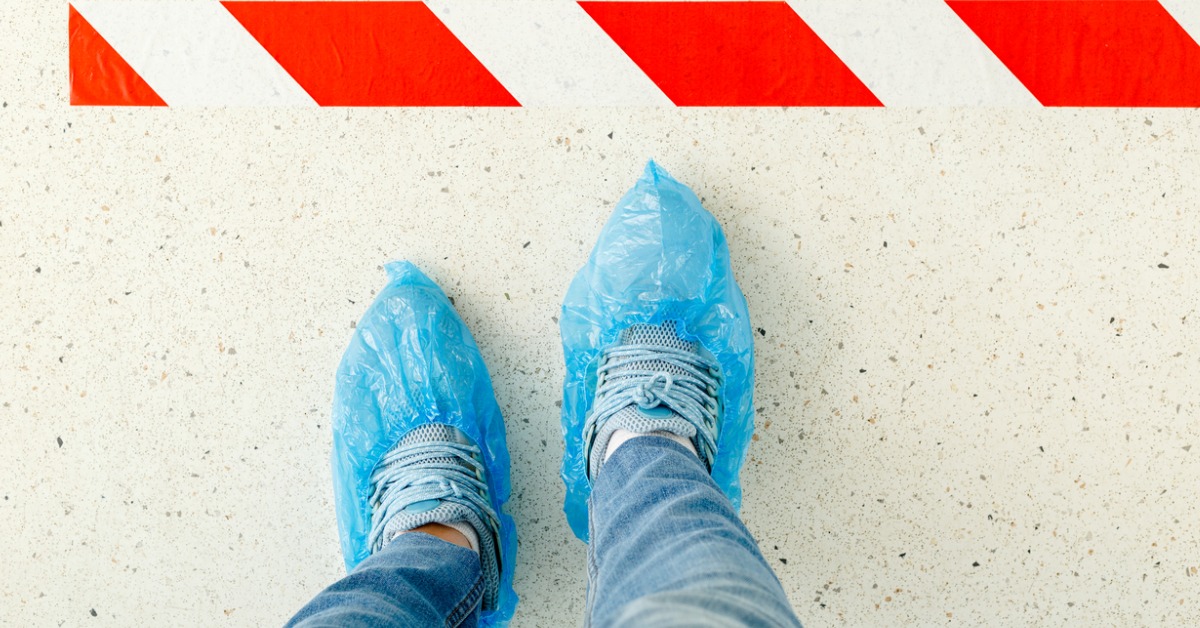
Unless you’re mopping your organisation’s floors every hour, it’s highly likely for these to be covered in harmful bacteria making its way onto other surfaces that we touch. The more bacteria making its way into the body, the greater risk of potentially life-threatening illness. Protective shoe covers keep bacteria and contaminants from transferring off our shoes.
How Dirty Are Our Shoes?
A study showed the average shoe has over 421,000 units of bacteria on the outside or soles of shoes, and another 2,887 units of bacteria can be found on the inside of shoes.
What Bacteria Is on Shoes?
The bacteria on shoes in the study included E. Coli which can cause intestinal and urinary tract infections, and some meningitis and diarrheal disease. E. Coli was found on 27% of the shoes and most likely comes from contact with faecal matter from public toilets and animals in outside areas. Other bacteria found includes serratia ficaria, which can cause rare infections in the respiratory tract or wounds, and Klebsiella pneumonia, which causes wound and bloodstream infections.
Does Bacteria Transfer from Shoes?
The study found the transfer of bacteria from shoes to uncontaminated tiles range from 90% to 99%. The good news is that washing your shoes with detergent reduces bacteria coliform from the soles by 99%. However, washing your shoes after every use and before you enter your home or workplace every day isn’t practical.
Benefits of Shoe Covers & Stopping Bacteria Transfer
#1 Bacteria from Shoes Can’t Transfer
Shoe covers enclose the dirt and bacteria that’s present on shoes. The bacteria on the soles of uncovered shoes can contaminate any surface they come in contact with. Wearing shoe covers in a commercial kitchen or factory ensures contaminants are contained and won’t transfer to the floor or food preparation surfaces. A shoe cover provides a barrier between the dirty shoe and a clean floor.
#2 Reduced Cleaning Time
Shoes track dirt and grime into homes and businesses. By asking visitors to cover their shoes at a real estate home open, the owners won’t need to clean the house again. Asking people to remove their shoes keeps the bacteria from the soles out of the home, despite now having to deal with the bacteria and marks on the floor from bare feet or steaming socks.
#3 Protect Shoes
Some occupations are a hazard to shoes. In the healthcare industry, a worker’s shoes are often the victim of blood, body fluids, secretions, and excretions. Waterproof shoe covers catch the spill and when the cover is removed, the shoes underneath will still be clean. Covers also stop the possibility of infectious diseases transfering to other areas of the hospital or into workers’ homes.
#4 Stop the Spread of Bacteria Into Clean Rooms
Shoe covers don’t just stop bacteria from the outside coming into a building. Some organisations have clean rooms where contamination and pollutants such as chemical vapour, dust, and airborne microbes are controlled. In these rooms, atmospheric conditions such as air pressure, humidity, moisture, and temperature are controlled. Putting the shoe covers on prior to entering a clean room ensures there is no introduction of pollutants from another part of the building into the clean room.
#5 Choose the Right Shoe Cover for the Job
There is a wide range of disposable shoe covers designed for different rooms including cleanrooms, laboratories, plants, hospitals, and home opens. The materials of the covers vary from plastic to fabric, and heavy duty hybrid covers.
Disposable shoe covers further reduce the risk of contaminating surfaces. If non-disposable shoe covers are used, the covers need to be kept in a safe place before washing. Taking them off and placing them on a bench will only make the bacteria transfer to people’s hands when they touch the benchtop surface and more likely, end up in their face and enter their body. Washable covers also have to be handled carefully to avoid the bacteria from the soles of shoes transferring onto the hands or clothes of the person doing the washing.
Disposable Shoe Cover Dispensers
Shoe covers have become far easier to attach to shoes since shoe cover dispensers and removers became available. A dispenser eliminates the need to bend over or balance on one foot to attach the cover. The automatic machines reduce the risk of injury due to losing balance as well as the time and effort required to cover shoes.
Protective shoe covers and dispensers are perfect for a range of industries, from healthcare to real estate, and help to keep surfaces free of bacteria. For more information, get in touch with Helix Solutions on 1300 29 32 32 or contact us online.